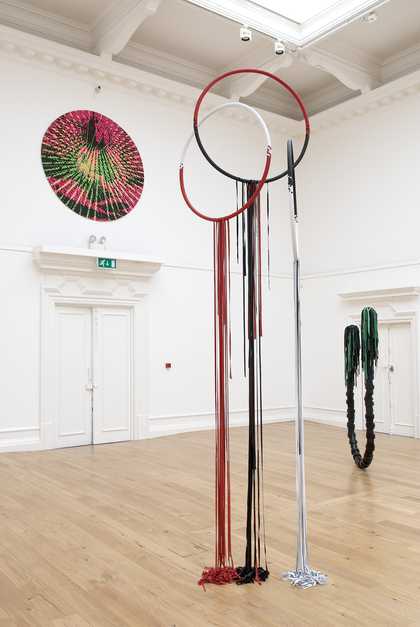Eva Rothschild’s sculptures have been likened to ‘artefacts from some lost civilisation or from some post-apocalyptic scenario’ whose symbolic meanings have all but faded from memory or lie just beyond our current imaginings. Though leavened by wit and humour, especially evident in the choice of titles, their occasional intimations of esoteric magic also hint at something darker. Many perch on spindly stands, while some jut out from high corners, or arc precariously overhead, or appear to hover improbably in mid-air, a narrow cascade of coloured leather strips obscuring their support. Though fundamentally stable, they often appear to twist on their axes or teeter precariously. Her lexicon of forms is instantly recognisable, but surprisingly varied. It includes thick lumpen masses, thin angular slabs, sinuous coils, woven sheets, shaggy fringes and, above all, slender rods of painted wood that kink crazily here and there, creating complex, off-kilter geometries in space. Her work is informed by the legacy of sculpture forged through processes of industrial production and, in common with that of a number of her peers, obliquely acknowledges the precedent of certain strains of 1960s sculpture, as well as more general aspects of 1960s counter-culture. Yet it has always seemed even more apparently indebted to the tradition of domestic or artisanal craftsmanship.
Despite an unerring command of the exhibition installation as a format, as seen in particular in her solo show at the South London Gallery in the winter of 2007, Rothschild has always insisted on her works as individual sculptures rather than elements in an installation. Her commission to produce a single sculpture for Tate Britain’s Duveen galleries has, however, provided the opportunity to work on an unprecedented scale. Running the length of the galleries, this new site-responsive sculpture, still in development and so far untitled at the time of writing (her pieces are never untitled), is designed to occupy a large space and yet will have little volume. Made up of a series of frame-like structures, some of which run along the ground and others of which are elevated, it is envisaged by the artist as a kind of “temporary architecture”, such that the engaged viewer navigating the space will sometimes feel as if he or she is “inside” the sculpture and sometimes “outside”. While many of her previous sculptures have made comparable use of open volumes, this commission has provided the welcome challenge to brush against the grain of auratic self-containment characteristic of much of her work in recent years.

Eva Rothschild at South London Gallery 2007 Left to right: Rising Sun, Higher Love, Cactus
Images courtesy Stuart Shave/Modern Art London, and The Modern Art Institute, Glasgow © Eva Rothschild
Faced with the potentially intimidating grandeur of Tate Britain’s central axis, there is an obvious temptation to take command of the space by responding in kind with a comparably imposing work of considerable physical substance. Richard Serra’s Weight and Measure, which occupied the galleries in 1992, is the most memorable precedent. Rothschild’s decision to opt for lightness rather than heaviness is nevertheless emphatic in its own way, as well as being entirely in keeping with the nature of her art. As she says: “I knew from the start that I wanted something that didn’t obscure the space, but that just tangled with your perception of it and travelled through it touching as lightly as possible on the architecture.” Colour has played an important role in Rothschild’s sculptural vocabulary too. It has been crucial, for instance, to many works employing woven patterns of almost psychedelic discordance. It has also functioned as a means of teasing the eye into confusing the thin zigzagging lines of a piece constructed largely of slender wooden batons. She was quite sure, however, that in this case her sculpture’s lines should be as clear as possible, hence the decision to limit herself to one colour – black. This decision is consistent with Rothschild’s long-standing ambition to produce the kind of sculpture that can be perceived to be complete and whole in itself, while simultaneously constituting a source of productive confusion to the eye and mind alike.
